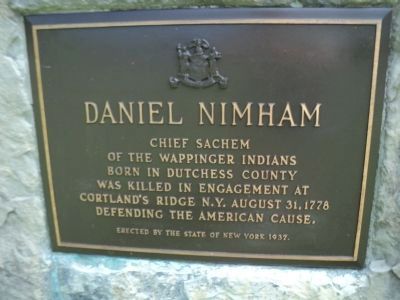
Chief Daniel Nimham was the last grand Sachem of the Wappinger Confederacy. While Nimham and other Wappingers fought against the French in the French and Indian War, their lands [in what became] Putnam County [NY] were usurped by Adolph Philipse. In 1766, Nimham traveled to England to challenge these fraudulent land titles in the British courts.
In 1774, the Stockbridge Indians—a community of Wappinger, Munsee and Mohicans living in Massachusetts—organized a militia or community defense an in solidarity with the American cause of independence. Capt. Daniel Nimham and his son Capt. Abraham [they were Christians], along with the rest of the Stockbridge Militia, served in every major campaign in the eastern theater of the Revolution.
By the summer f 1778, the Stockbridge Militia was stationed at an outpost near Fort Independence in the Bronx. This area—between British-occupied Manhattan and the main American forces in White Plains—was a no man’s land and the scene of constant skirmishes and ambushes from both sides. On August 31, 1778, Chief Nimham and the Stockbridge Militia were surrounded and killed by British Dragoons and Hessians under the command of Lt. Col. John Graves Simcoe [best known as an evil villain in the AMC series “Turn” and as a hero and founder in Toronto]. (From a DAR/SAR Brochure)
HONOR
Daniel Nimham has been honored. A cairn of boulders and plaque at Indian Field in Van Cortlandt Park in the Bronx near the site of Nimham’s death, honors him and his fellow warriors. In 1906, the Westchester Historical Society and the Mount Vernon Chapter of the Daughters of the American Revolution created this historical honor.
On August 31, 2021, there was a ceremony at the Nimham Monument (which I attended). The event was organized by the Col. Benjamin Tallmadge Bronx Chapter of the Daughters of the American Revolution, the Albuquerque Chapter of the Sons of the American Revolution, and the Knightsbridge Historical Society.
In the dedication of Seven Wappinger Stones, the following nations within the Confederacy were honored:
Wappingers (Wappingers Falls, Dutchess County)
Nochpeem (Carmel, Nimham Mountain, Putnam County)
Siwanoy (Bronx, Hunters Island)
Weckqueskee (Dobbs Ferry, Westchester County)
Sink Sink (Ossining, Westchester County)
Rechewani (Manhattan).
As you can see from the list, there is a mountain in Putnam County named after Nimham. It is near where the Nimham Mountain Singers hold an annual pow-wow in August for the public. The headquarters for the organization is located on Chief Nimham Drive in Carmel, NY.
By coincidence, I had alerted a colleague in Fishkill about the event in the Bronx. He arranged to have the municipality present at the event and to participate. They did so because Nimham had either had been born there or lived there. The municipality is arranging to dedicate an eight-foot tall bronze statue in his likeness probably in the spring, 2022. The statue will be located in the hamlet of Wiccopee, in East Fishkill, named after a Wappinger sub-tribe.
So there are multiple ways in which Chief Daniel Nimham has been honored. But would you name a school after him and have him as your school mascot?
ERASE
At the same time Nimham has been honored and in the same area of the Wappinger Confederacy, there also has been an ongoing effort to erase the Indian presence from school mascots. True the examples of the dispute are not for Nimham himself or either for the Wappingers. It is not my intention here to chronicle chapter-and-verse the various community fights over the maintenance or removal of Indian mascots particularly as they relate to high school football teams and other sports. These include:
Cross River John Jay High School Indians: changed
Mahopac Indians
Nyack Indians: changed
Wappinger Roy C. Ketcham Indians.
A student petition says:
The Roy C Ketcham High School and Wappingers Junior High School both have the mascot the Wappinger Indians. A human being should not be a mascot. This is offensive and damaging to students and community members who are Indigenous people.
This is an example of teenage idealism at its purest. However, an adult version of these sentiments has been proposed as well in the state legislature that would ban New York schools from using Indian names, logos, and mascots beginning in 2024.
Dr. Ian Record of the National Congress of American Indians said in July, 2021:
The use of Native American sports mascots, logos or symbols perpetuates stereotypes of American Indians that are harmful. The “warrior savage” myth has plagued this country’s relationship with the Indian people as it reinforces the racist view that Indians are uncivilized and uneducated.
Heather Bruegel, a historian and cultural affairs director of the Stockbridge-Munsee community now based in Wisconsin said the people were not honored by names such as “Chiefs,” “Warriors,” and “Braves” which are offensive. She would prefer that the history would be taught accurately in the schools.
The Stockbridge Indians are aware of the honoring of Chief Nimham for his actions as a presumably brave warrior. To the best of my knowledge they have launched no campaign to topple the monument and markers to Nimham and his fellow warriors in the Bronx and Putnam nor to the statue to him being planned for the spring.
It seems that words like “warrior,” chiefs,” and “braves” only apply to Indians and to no other peoples. Apparently Achilles was not a warrior. It remains to be seen what would happen if a school or sports team kept the warrior name and changed the mascot. Klingons anyone?
One suggestion made in the discussion was that Nyack Indians become the Nyack Lenape after the people who lived there. That suggestion failed. The dominant decision is the best Indian is an erased Indian.
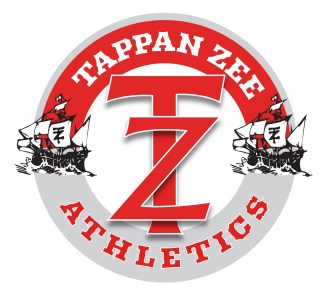
Consider for example, the Tappan Zee Bridge. It famously combines the Dutch and Tappan Indian heritages in its name – the name of a people and the Dutch word for “sea” at this wide point in the Hudson River. However the mascot of the Tappan Zee High School recognizes the Dutch heritage but ignores the Tappan. They have been erased.
The Village of Ossining, named after one of the people part of the Wappinger Confederacy, is debating removing the Indian profile from its seal. It already changed the nick name of the high school from Indians. While the erasure of the Indian heritage is not complete in the village, one can anticipate that it will occur.
Most likely the same fate awaits the Lenape, the Stockbridge Indians, and the Wappinger Confederacy wherever the name changes have occurred. The purification process leaves no trace behind. Perhaps Sing Sing, Wappingers, Wiccopee, Tappan, and Katonah will have to change their names as well when the next generation of idealistic teenagers finds a cause.
HONORING INDIANS
The Chicago Black Hawks are a hockey team named after an individual named “Black Hawk.” According to a team statement:
The Chicago Blackhawks’ name and logo symbolizes an important and historic person, Black Hawk of Illinois’ Sac & Fox Nation, whose leadership and life has inspired generations of Native Americans, veterans and the public.
We celebrate Black Hawk’s legacy by offering ongoing reverent examples of Native American culture, traditions and contributions, providing a platform for genuine dialogue with local and national Native American groups. As the team’s popularity grew over the past decade, so did that platform and our work with these important organizations.
Needless-to-say the team is under pressure to change the name and mascot.
The Spokane Indians, a minor league baseball team, has a similar experience to the Chicago Black Hawks except it is named after a people and not an individual. At one time, the Indian mascot had nothing to do with the actual Spokane Indians located approximately 40 miles away. Now there are regular meetings between the tribe and the team. The mascot has been changed to a trout for a traditional food source of the people. The name on the team uniform is in Salish the language of the Spo-ka-NEE. Exhibits of the culture and history of the people have been placed in the stadium. An advertisement on the scoreboard depicts a traditional Spokane tribe person in headdress. And the nickname of the high school on the Spokane reservation is “Redskins” which does not seem to bother the people there. Obviously both the team and the people are in major need of cleansing and purification to meet Woke standards.
A reporter spoke to the chairwoman of the Spokane Tribal Business Council, Carol Evans:
…she expressed great pride in the partnership and emphasized the fundamental difference between the Spokane Indians baseball club and other teams. “We are not their mascot,” she said. “They’re named after our tribe.”
The Florida State University provides another example of a win-win solution. From its website:
In the late 1960s and early 1970s, FSU’s campus became a learning ground with regard to the Florida Seminole Indians. Several key people were directly responsible for the new awareness. Joyotpaul “Joy” Chaudhuri, an American Indian expert and FSU professor of political science, and his wife, Jean, an American Indian activist, came to the university during this period. They helped establish an American Indian Fellowship at FSU. This influential group led the campus and the community toward a better understanding of Native Americans in general and the Florida Seminoles in particular. The group was instrumental in mediating between the university and the Florida Seminole Indians. There were several meetings between the two, and problems were addressed to the satisfaction of both. As a result, FSU retired certain images that were offensive to the tribe, and began consulting with the tribe regularly on all such matters.
By the late 1970s, FSU’s campus, like the rest of country, had become more educated about Indians in general and the Florida Seminoles in particular. Along with this new understanding came major changes in the university’s mascots. It became very important to portray the university’s namesake with dignity and honor, and to do it with the graces of the Florida Seminole tribe. This attitude culminated in a mutual respect between the two institutions, and further tied their futures to one another.
Osceola and Renegade
In 1978, FSU embarked upon a new tradition — one that had the full endorsement of the Seminole Tribe of Florida. A Seminole warrior riding a horse, to become known as Osceola and Renegade, was introduced at FSU home football games, and soon became one of the most enduring and beloved symbols of the university.
For more than 30 years, FSU has worked closely with the Seminole Tribe of Florida to ensure the dignity and propriety of the various Seminole symbols used by the university. The university’s goal is to be a model community that treats all cultures with dignity while celebrating diversity.
A recent article provided these quotations:
“Florida State University’s official use of the Seminole name is different from other names in that it does not perpetuate offensive racial stereotypes nor is it meant to diminish or trivialize any Native American or indigenous peoples. Instead, it is used with explicit tribal permission and involvement to honor and promote the Seminole Tribe of Florida’s unconquered history and spirit that persists to this day,” Elizabeth Hirst, FSU’s chief of staff and liaison to the Seminole Tribe, told the Tampa Bay Times in 2020.
Ask the Seminole Tribe, and they’ll tell you similarly.
“The Tribe views the relationship as a multi-dimensional collaboration that provides meaningful educational opportunities and other positive outcomes,” tribe spokesman Gary Bitner told The Times.
One would think that the same such partnerships could be created elsewhere even at the high school level. The fact that such partnerships are never even considered is a sign of how the dialog has degenerated.
INDIANS AND INDIAN MASCOTS
During all these confrontations over Indian logos, they remain quite common for Indian organizations and colleges.
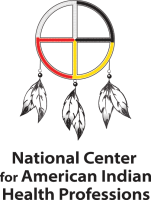
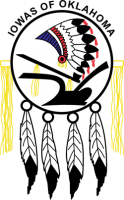
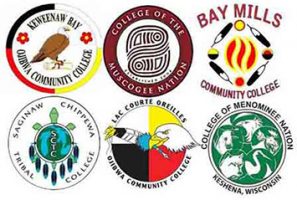
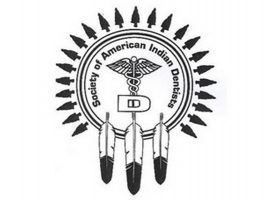
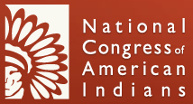
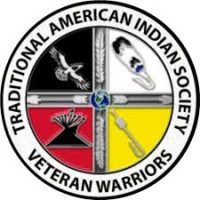
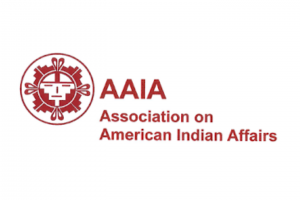

Two observations come to mind here. One big difference between Americans and Indians in logos relates to individuals. Americans love individual symbols. Think of Uncle Sam and Liberty as symbols of the country as examples. Even our nation’s capital is named after an individual. By contrast the Indian logos seem more symbolic or metaphorical. I suspect there is a real cultural difference here. That is why in the land of Daniel Nimham a school can be named after fellow American Revolution hero John Jay but not after Nimham.
Second, all these Indian organizations are still named “Indians.” By contrast when Negroes became African American, all Negro organizations were obligated to change their names accordingly. Apparently white people have yet to be as successful in getting Indians to abandon their names and become “Indigenous.” Dr. Ian Record of the National Congress of American Indians used the term “Indians” three times in two sentences (above). On the other hand as the student petition suggests (above), idealized (white) teenagers have now been educated to never use the word “Indian.”
INDIAN CITIZENSHIP ACT OF 1924 CENTENNIAL
In a previous blog (What Are You Doing for the Indian Citizenship Act (1924) Centennial?), I suggested that the Indian Citizen Act centennial provided a convenient opportunity to discuss the ongoing problems related to the place of Indian Nations and Indian individuals in America. Lord knows, there is plenty to discuss.
As I read the plethora of news articles from my local paper about mascots, I realize that such discussions are a farfetched pipedream. There can be no “come-let-us-reason-together” in a moral cultural war. There can be no healing in zero-sum confrontations. The stories of Daniel Nimham, Chief Katonah, and the Wappinger Confederacy provide an excellent example of the potential opportunity to begin such a dialog. The absence of his name from the mascot discussions which have been held so far reveal that there is no chance of such healing discussions even being started yet alone succeeding.
BREAKING NEWS! BREAKING NEWS!
This just in. This just in. The Quakers have demanded that Horace Greeley High School in Chappaqua (NY) and the University of Pennsylvania change their mascots and nicknames immediately under penalty of eternal damnation.






No, no, no. Chief Nimham should not be erased as a hero, which he was.
However, he should be erased as a mascot.
Willa E. Skinner
Fishkill Municipal Historian Emeritus
Hi Willa,
Nice to hear from you. Chief Nimham can’t be erased as a mascot since he isn’t one. I was questioning why a school could not be named after him as the one for John Jay is.
Peter
Another great piece.
Loved this quote: “A human being should not be a mascot.”
Two examples come immediately to mind, the former with great pride, and the latter with some controversy:
https://en.wikipedia.org/wiki/Raider_Red
https://library.gwu.edu/nicknames-and-mascots
Best—
Lee
Lee Wright
Founder, The History List | History Camp
TheHistoryList.com
I enjoyed reading that remark. I hope the student has had an opportunity to realize how silly it is. Teenage idealism can be passionate even when it doesn’t make sense. You are right to note the existence of mascots of white individuals and white peoples.
Great article!
This article makes too much sense.
It will be my bible.
Thomas X. Casey
Kingsbridge Historical Society
Bronx NY 10471
Hi Peter,
If I recall, Daniel Ninham and his men went off to fight in the French and Indian War, and returned to find that their lands had been confiscated. His story deserves a first-rate biography. Perhaps you know somebody capable of the task.
I mentioned Ninham’s last battle when driving by there with my pal Murphy. I wasn’t sure of the precise location, but it seems that I drove directly over the battlefield site on VC Pk E. Have to check out the monument next time I’m in the area.
Have Revolutionary War re-enactors ever staged the battle near the site?
I wonder if the Woodlawn area Irish enclave would be interested in adopting Chief Ninham as a fellow warrior against the Brits.
BTW, as I continue my project work, now doing a deep-dive into Biblical history, your book is next on my reading list.
Walt
The site we walked to was in the woods. Any ceremony needs to be where the cairn us right off the street.
Your point about the Irish is well-taken. One of the reasons Evacuation Day endured as a holiday in the 19th century was because the Irish immigrants in New York loved to celebrate the British defeat.
Thanks for getting my book.
Good job Peter!
I object to the assumption that “mascot” is a pejorative. In that line of thinking, since it was the Europeans who were the ones who fraudulently stole all the Native American lands through various means, including counterfeit signatures, boundary issues, and even the copious use of alcohol to a culture who had never in 10,000 years used it, then all Europeans must first apologize then move back to their lands of origin. Stupid, of course, but not any more stupid than saying it is a demeaning thing to honor and remember them.
Where does it say that “mascot” is a bad thing?
Words mean what people want them to mean and then have to get others to accept the meaning. I think the problem here has been with the caricature of Indians in a generic sense rather than on any individual Indians. If the mascots had been respectful as they are for white people there probably would not have been the problem.
Stop with this “retroactive canceling”. He was honored for what did with the American Army against the British.
I am not quite sure what you mean here. Nimham has not been cancelled.
Can we republish your article in Teaching Social Studies, a joint publication of the New York and New Jersey Councils for the Social Studies?
Alan Singer, Director, Secondary Education Social Studies
Teaching Learning Technology
290 Hagedorn Hall / 119 Hofstra University / Hempstead, NY 11549
(P) 516-463-5853 (F) 516-463-6196
Hi Peter,
My wife just found this blog and passed it on to me, or I would have chimed in sooner….For the past 20 years I have been researching and compiling information about the Sachem Daniel Nimham for a sculptural tribute to him somewhere in the Hudson Valley. It all began really in 2002, with creating a small sketch of Nimham to promote to local towns. In 2019, I got a call from newly elected Supervisor of Fishkill Ozzy Albra asking if I would still be interested in creating it for the town. Our location for the 8′ sculpture will be at routes 52 and 82 exactly where the plaque on a rock was dedicated in 1937. I am actually using the same but restored plaque for the front of the 5′ tall base on which the 1 ton statue of Daniel Nimham will be mounted. For me the statue is not only a memorial to Nimham, Wappingers, Mohican and to all those Native People of the Hudson Valley Region and New England are. It is of course a memorial to all those Native People who died taking up arms for the American Cause. Some of America’s first Veterans are Native Americans. George Washington desperately needed Native People on the Continental side during the battle with Great Britain. We all know the sad story, they the Native Americans received nothing for their sacrifice and were quickly pushed out of the way. The sculpture is almost completed and we should be starting the ground work and base at the site soon. My hope is the sculpture of Nimham is an inspiration to all of us who strive for better things for our fellow human beings. The sculpture while closely historically correct as possible, combines symbolism and allegory that help to share Nimham’s story as well as his people’s. I have been fortunate to have a filmmaker Jeff Hodges volunteering his time and effort since I began working on the sculpture in 2020, filming in detail. More information and episodes of the process can be found here: https://www.keropiansculpture.com/daniel_nimham.html
Supervisor Albra and myself are hoping to have a wonderful spiritual celebration and dedication in the Spring 2022.
I am looking forward to attending the ceremony. I presume there will be one once the statue is unveiled.